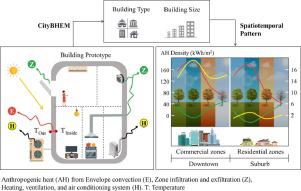Resources, Conservation and Recycling ( IF 13.2 ) Pub Date : 2021-11-02 , DOI: 10.1016/j.resconrec.2021.105996 Wei Chen 1 , Yuyu Zhou 1 , Yanhua Xie 2 , Gang Chen 3 , Ke Jack Ding 1 , Dan Li 4

|
Anthropogenic heat (AH) emission from buildings is a key contributor to the urban heat island (UHI) effect. Although an improved understanding of spatiotemporal patterns of building AH is highly needed for mitigating UHI effect, such information is still limited in high spatiotemporal resolutions at the city level. In this study, a bottom-up city building heat emission model (CityBHEM) was developed to investigate temporal variations of building AH from three components (i.e., envelope convection, zone infiltration and exfiltration, and HVAC system) for all buildings in Boston, United States. First, buildings in Boston were grouped into eleven commercial and five residential building prototypes based on building type, construction year, and foundation type. Second, an end-use-based calibration was developed to calibrate CityBHEM using U.S. Energy Information Administration's survey data. Finally, AH from all buildings in the city under actual weather conditions was calculated using the calibrated CityBHEM model together with building types and sizes. Results indicate that total building AH density of Back Bay neighborhood reaches the maximum value of 526 kWh/m2 in summer (56% of HVAC system and 44% of envelope convection) and the minimum value of 369 kWh/m2 in winter (54% of HVAC system, 24% of envelope convection and 22% of zone infiltration and exfiltration). In contrast, total building AH density of suburban neighborhoods is lower than 30 kWh/m2 in summer and 20 kWh/m2 in winter. Given that key inputs are publicly available, CityBHEM is transferable to other U.S. cities, enabling us to explore practical building energy-saving strategies for mitigating AH.
中文翻译:

使用自下而上的城市建筑热排放模型估算城市建筑人为热的时空格局
建筑物的人为热量 (AH) 排放是城市热岛 (UHI) 效应的关键因素。尽管对于减轻 UHI 效应非常需要更好地了解建筑 AH 的时空模式,但此类信息在城市级别的高时空分辨率中仍然有限。在这项研究中,开发了一种自下而上的城市建筑热排放模型 (CityBHEM),从三个组成部分(即围护对流、区域渗透和渗出以及 HVAC 系统)研究美国波士顿所有建筑的建筑 AH 的时间变化。状态。首先,根据建筑类型、建造年份和地基类型,波士顿的建筑被分为 11 座商业建筑原型和 5 座住宅建筑原型。其次,开发了基于最终用途的校准,以使用 US 校准 CityBHEM。能源信息署的调查数据。最后,使用校准的 CityBHEM 模型以及建筑物类型和尺寸计算实际天气条件下城市所有建筑物的 AH。结果表明,后湾社区总建筑AH密度达到最大值526 kWh/m夏季为2(暖通空调系统的 56% 和包络对流的 44%),冬季最小值为 369 kWh/m 2(暖通空调系统的 54%,包络对流的 24% 和区域渗透和渗出的 22%)。相比之下,郊区社区的总建筑AH密度夏季低于30 kWh/m 2,冬季低于20 kWh/m 2。鉴于关键投入是公开可用的,CityBHEM 可转移到美国其他城市,使我们能够探索减轻 AH 的实用建筑节能策略。



























 京公网安备 11010802027423号
京公网安备 11010802027423号